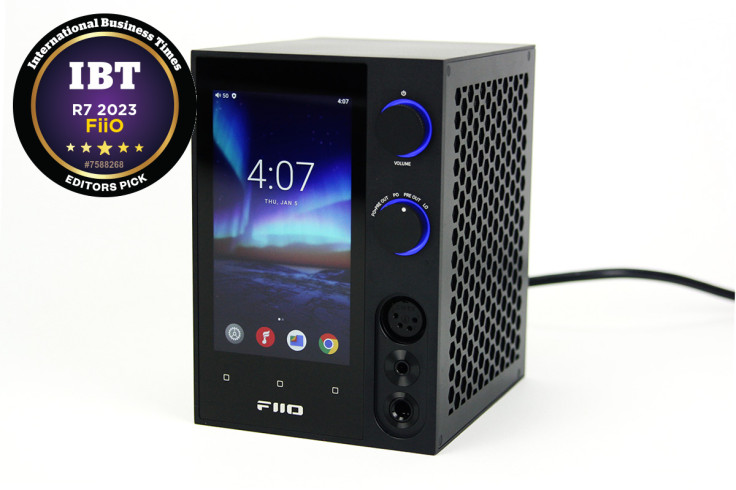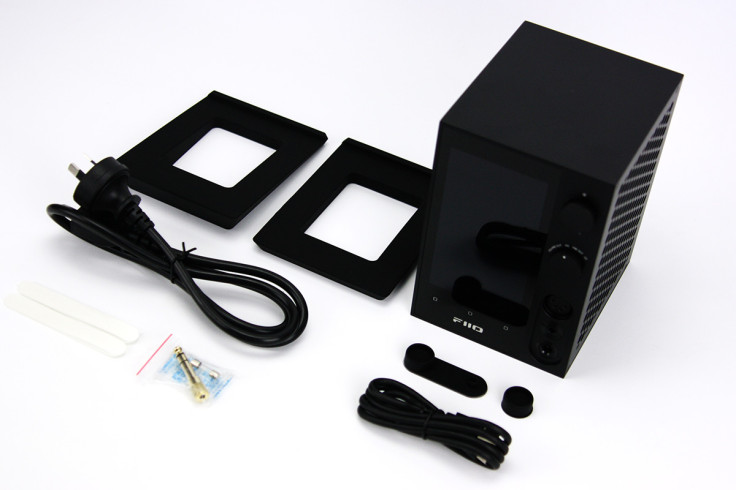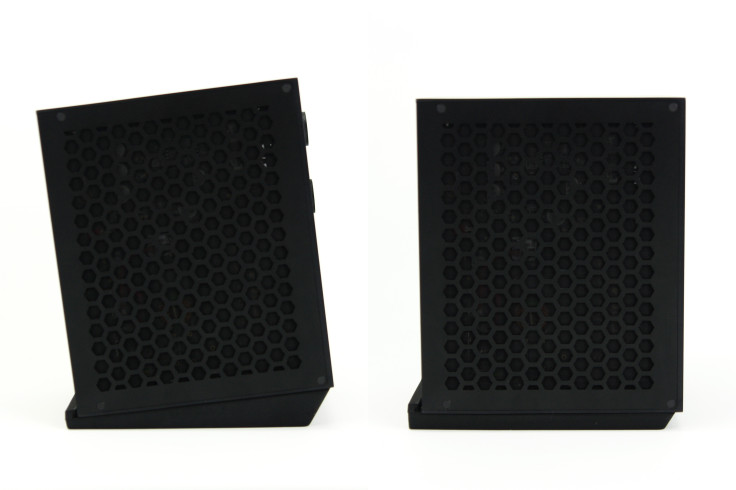FiiO R7 Desktop Media Player Hands-on Review: All-in-one Without Compromise?

Being one of the biggest names in Chi-Fi, FiiO has made a name for itself by creating products that satisfy audiophiles with their sound quality, while also providing multifunctionality at a reasonable price point. For example, the K9 Pro, FiiO's flagship desktop DAC and headphone amplifier, already offers customers an array of single-ended and balanced outputs. However, the design team decided to take it a step further by adding Bluetooth connectivity that supports aptX HD and even LDAC for even more versatility.
Just when we thought FiiO couldn't pack any more functionality into its devices, the Guangzhou-based audio company introduced a new category in its catalog by creating the R7. Its official title is a "desktop high-resolution transmitter, decoder, and headphone amplifier all-in-one unit." If that seems like a mouthful, it's because that's precisely the kind of machine it aims to be. But can the new FiiO R7 truly fill all these roles while maintaining its high standard of sound quality? Let's dive in to find out.

Mysterious Monolith
A single glance at the R7, and it's clear that FiiO is breaking new ground. Rather than sticking with its "oversized chamfer" design style, the R7 unit itself is a perfect rectangle with eight right-angled corners. Combined with its anodized matte black finish, it's an object to behold on any desktop.

Adding to the intrigue while also providing ample cooling, the two sides of the R7 are covered by hexagonal mesh grids that ensure excellent heat dissipation while also providing a view of the internal components of this enigmatic device. FiiO made its intentions perfectly clear by including two massive heatsinks: one covering the dual ES9068AS DAC chips, and the other covering the dual THX AAA788 amplifying chips.

True Desktop DAP
For those familiar with FiiO products, I would say that the R7 can be considered the true desktop version of the M17 DAP in its product lineup. Although the M17 comes with a cooling stand, it remains a portable digital audio player at heart. While it can be used as a desktop device, with headphone jacks sticking out from the top and a USB cable going into the bottom, it looks more like a piece of experimental gadgetry. In contrast, the R7 places most of its I/O ports on the rear, leaving the front face clear and tidy, with only the volume knob, output selector knob, and headphone sockets easily accessible.
The other significant element on the front of the R7 is the 4.97-inch display, which is the true differentiating point between the R7 and other DAC/Amps from FiiO. The glass panel is perfectly flush with the metallic cuboid, a finish that is typically found on luxury Hi-Fi products. The high-performing touch screen is exactly what you would expect to find in any flagship Android device: smooth animations, zero-latency touch input, and high brightness for clear visibility.

On the business end of the R7 - its rear - FiiO has included as many input/output options as one could ever need. In addition to the usual line in and out, there are dual XLR outs, as well as optical and coaxial inputs and outputs. A 100M Ethernet port is also available for wired network connectivity. In terms of media access, there are both USB-C and USB-A ports that can access external hard drives, and there is even a standard SD card slot.
As if these options were not enough, FiiO has included two power input options: both DC and AC, so that one has the option of using the device with a low-noise regulated linear power supply such as the FiiO PL50.

Sound Check: Power and Precision
The multifunctionality and versatility of the R7 are undoubtedly beyond anyone's shadow of a doubt, and there is nothing for anyone to complain about. However, what audiophiles might take issue with is the 'compromise' that an all-in-one device would bring to sound quality. So the big question is: how does it sound?
To answer this question, I've tested the FiiO R7 with a range of headphones: From the Meze Elite, to the Audeze LCD-2C, to the Sennheiser HD660S and even the new HD660S2.
The first thing that should be addressed is the matter of power. Like its hardware, the R7 offers a plethora of choices when it comes to gain adjustment. There are a total of five levels of gain: from Low, Medium, and High to Super High, and it tops out at Ultra High. This allows the user to choose the best gain for their particular headphone or earphone. When it comes to the matter of raw output power, I find myself rarely going over the halfway point at 'Ultra-high' gain and a balanced output. The maximum output on the R7 is a whopping 3,000 mW, almost 1,000 mW higher than the K9 Pro. With this kind of power, there aren't many headphones on the market that the R7 can't drive - including the 300 Ohm Sennheiser HD600S2, which I tested and is the headphone with the highest impedance in the office.
As any audiophile would tell you, having more power doesn't necessarily mean the amplifier is able to open up the headphone to its full potential. Loudness is not equivalent to character. Out of all the headphones that I tested the R7 with, I found that it opened up the sound of the LCD-2C surprisingly well. As any owner of the Audeze planar headphone would know, the LCD-2C with its warm and dark characteristics is one of the hardest headphones to drive. However, when paired with the R7, the timbre comes alive, the soundstage opens up, and the instrument separation that is usually muddled becomes clean. Pair all of this with the towering sound of the 2C, and you get an amazingly immersive listening experience.

Android 10 Operating System
Although it's standard for FiiO to use Android, it's worth noting that with the R7, you won't be dealing with any obscure custom software that you'll need to learn from scratch. The best aspect of using Android 10 is the ability to download any software from the Google Play Store, whether it's a music player, streaming software, or anything else you desire.
For the purists out there, FiiO has included the ability to switch the Android OS to a Pure Music Mode, USB DAC Mode, Bluetooth Receiving Mode, or AirPlay Mode.

Wealth of Accessories
Another area where FiiO is consistent is in the inclusion of an abundance of accessories, which ensures that the buyer never needs to make another purchase to make the most of their products. The R7 is no different in this regard.

Two accessories are especially noteworthy: the first is the inclusion of two kinds of bases. The soft rubber-covered bases elevate the R7 unit above the desktop and allow for two kinds of setup. One allows the unit to slightly tilt up, which would make it match the first set of speakers that FiiO will be releasing later, as well as making it easier to access the touch screen. The second base is flat and would be suitable for those who want a 'bookshelf' look, matching the vertical and horizontal lines of book stacks. FiiO also includes double-sided tape to fix the unit to the base of your choice.
The second surprising accessory that comes included with the R7 are the dust proof plugs - which I have appreciated even on the M17 player. Again, two options exist, and you can either only plug up the 4-pin XLR balanced port when it's not being used, or you can plug the entire front port section to use the R7 exclusively for its rear outputs. The face of the plugs are in matching anodized matte finish as the main unit, and creates a flawless look when installed.

Final Verdict
FiiO's first entry into the desktop media player market is a culmination of research and development across multiple product lines, ranging from premium-grade desktop DAC/amps to powerful DAPs that can handle even the most difficult-to-drive headphones, as well as streaming solutions. The R7 represents the logical next step for FiiO's product lineup. Although it is a new addition to a new category of products, FiiO's solid groundwork ensures that this is by no means a halfhearted attempt at something new.

Instead, the R7 embodies everything that customers love about FiiO - multifunctionality, premium build quality, and intuitive operations. What's more, during our time spent with the R7, we paired it with multiple headphones and found that it was capable of delivering exceptional sound even with difficult-to-drive planar headphones. Even without testing the R7 with FiiO's own speakers, it has already proven its worth as an all-in-one media player. We are awarding the FiiO R7 with the IBTimes Editor's Pick badge.
David is a tech enthusiast and writer who is frequently on the move. However, since the pandemic, he is now on a mission to explore gadgets that can enhance his home work environment. This article is a contribution to IBTimes' ongoing review series on gadgets for home productivity.
© Copyright IBTimes 2025. All rights reserved.




















